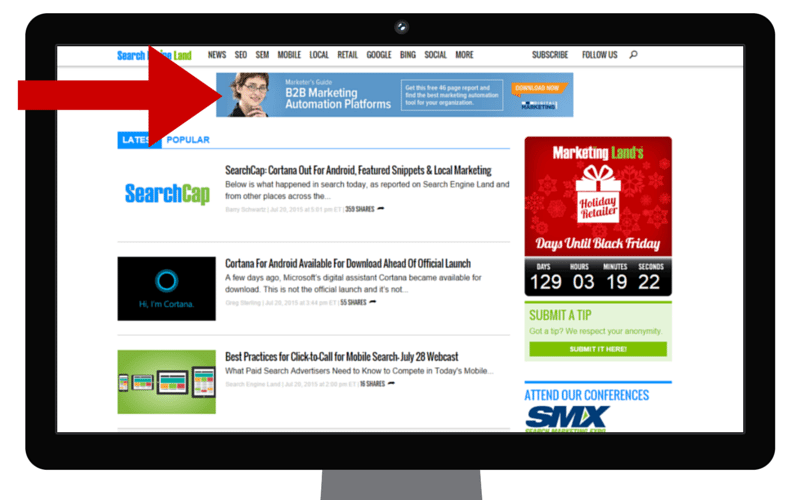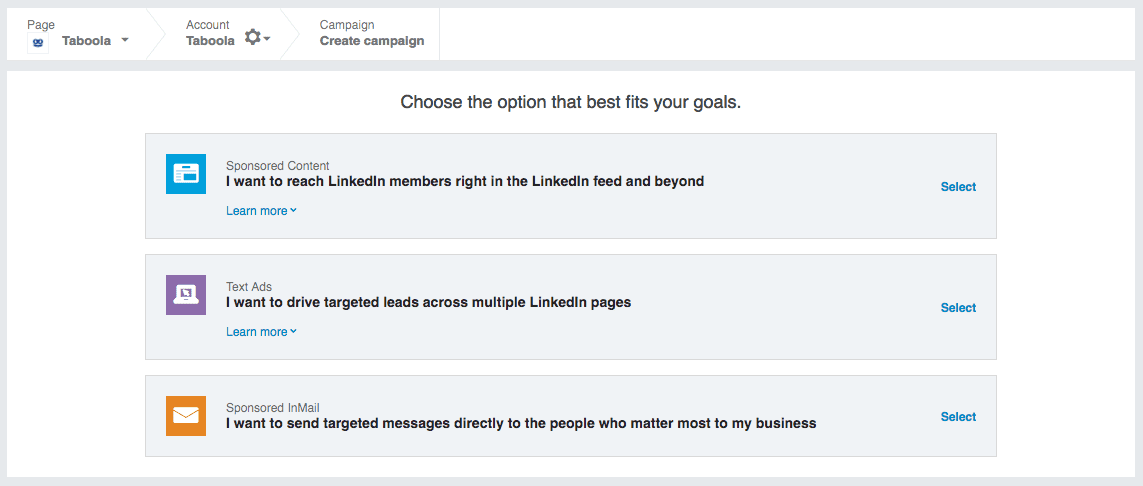So, you already have some killer content. You’ve got a rockin’ business blog, a couple of e-books, maybe a report of some kind, and an infographic or two. You’ve shared these pieces of content on your organic channels of choice—social media, popular forums like Reddit and Digg, blasted your email list and sent it off to a few influencers.
For some reason though, you’re just not gaining the traction you expected. You need a solution for better promotion. Paid distribution—aka, promoting your content with some budget—might be your answer.
Doing so can jumpstart engagement at the launch of a campaign when your content just isn’t sticking. It can also revitalize old content, and give further reach to what your audience has already proven they like.
The world of paid distribution is vast, and frankly, can be a bit confusing if you’re new to it—this is your easy guide to paid content distribution—a brief overview of everything you need to to know about your options for paid advertisement.
Discovery and native advertising.
Native Advertising is defined as a form of paid media where the ad experience follows the natural form and function of the user experience in which it is placed.
When marketers think of native ads, they think of something akin to discovery content campaigns, where content appears programmatically underneath similar articles in a related content widget. Other types of native ads on the web often spring from direct relationships with publishers.
Taboola
I couldn’t talk about paid promotion without talking about Taboola—the number one platform for brands to reach potential customers across the world’s most popular websites, now working with The Trade Desk to give brands access to one billion users.
With Taboola, you pay to promote your content on trusted publisher websites. In return for your investment, you get access to that publisher’s audience and can merge your content into the user experience of the publisher website.
Users find your content through the Taboola platform, on a publisher site they’re already interacting with, without disrupting content consumption habits. This mindset primes your audience to discover something new, just as they’re approaching the end of an article.
While we’ve taken the time to carefully research best practices for creatives and content, consider these tips when you’re just starting out:
- Content quality: the trick to all native advertising—especially discovery—is good content; be authentic and provide value for the readers.
- Distribute wisely: pick the right publishers for the audience you need, consider location and target based on relevant content nearby.
- Think long-term: you need to run campaigns for at least a year to see results
For content marketing powerhouses, it can be common to work directly with publishers for large branded native campaigns.
Publisher Partnerships
While promoting content on publishers sites is common, some brand and publisher partnership campaigns—like GE and BuzzFeed’s Flight Mode—go the extra mile to promote branded content.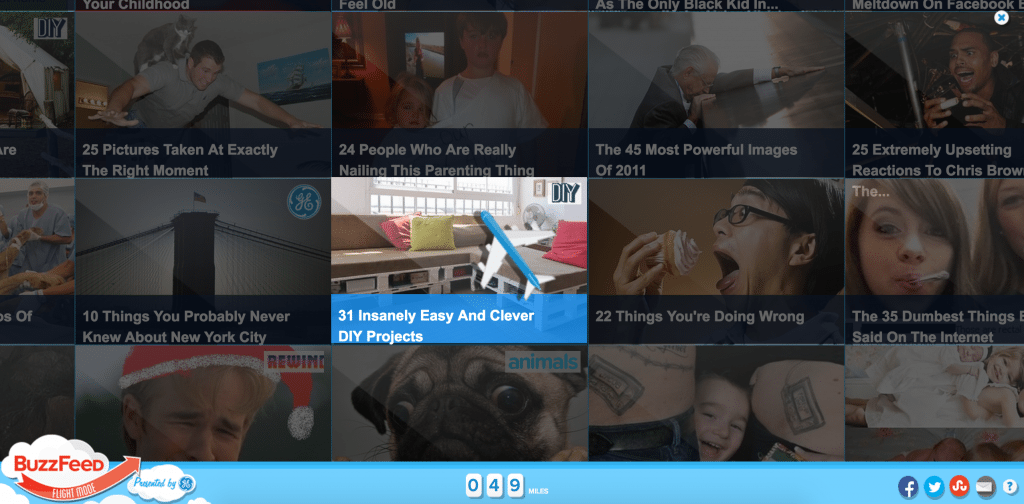
These type of campaigns result from strategic partnerships between brands and publishers—and usually require a hefty investment on the brand side. They lend brands the production resources needed to create quality content at scale, while still including their brand message.
This type of paid content sponsorship isn’t something you’ll do when you’re first starting out, but there is one best practice we wanted to highlight:
- Content quality: your content has to be produced with journalistic integrity, clearly labeled as sponsored, and ads should be designated in one ad area. If users don’t trust your content or find it valuable, they’ll label it an ad and disregard it.
Sometimes grouped as another type of native advertising—pay per click (PPC) ads—are diverse enough to become a category of their own.
PPC Ad Networks
Most likely, when you think of advertising options to promote your content, you think of PPC. Marketers pay to feature your ad content in search engines, banners, or in-line with text on relevant publishers on the web.
This is the most common way to boost a brand’s visibility online. When you promote your content with a PPC structure, you’re attracting clicks from users—when the user clicks on your ad, the marketer pays per click.
Search Advertisements
When you’re searching for something you need on the web, you’re most likely going to start with a search engine—and that search engine will most likely be Google.
Search ads require you to determine specific keywords in which you’d like to advertise. When a user searches for this keyword, they will see your advertisement. Marketers are required to pay a given amount each time an ad is clicked—selecting relevant keywords is key to success.
The most common ad exchange is Google Adwords, but there are many others including Bing Ads by Microsoft.
For first time users of search advertisements, focus on the following:
- Strategy: choose your keywords wisely—they should be relevant to your target audience, your content, your sales funnel and your brand.
- Content Quality: write engaging content. The more value users find in your content, the better Google will reward you for your efforts organically and in paid advertisements.
- Call-to-Action (CTA): Include a strong CTA in the text of your search ad to entice users to click. Be clear—“find out more” is not as clear as “Click to see the Article.”
Similar to search advertisements, banner ads are short snippets of text, imagery or media that appear on all types of websites, through which marketers have to pay by the click.
Banners and In-line Advertisements
While banner ads and in-line advertisements are becoming a bit outdated, they’re worth mentioning. Wikipedia defines “banner ad” as an advertisement delivered by an ad server. Banner ads are often placed at the top of a web page just below the nav, or in the left or right rail of the web page.
In-line advertisements are similar to banner ads—they are text advertisements or graphic advertisements that appear in-line with a body of text, and are often also delivered by an ad server. In some cases, they’re placed manually.
Before you dive into banner and in-line advertisements, I suggest taking a look at some recent studies that suggest these methods are becoming less and less effective—but they’re not dead yet.
Nevertheless, for many marketers, they’re still a part of their digital marketing strategy. If they’re something you think might be worth trying, here are a couple of tips to start:
- Distribution: if you’re going to run banner ads, be sure they’re targeted to the right audience and publication.
- Content Quality: because of the dwindling effectiveness of these ads, quality is key. Be sure to provide value to your audience first, before promoting yourself.
- Testing: Keep a close eye on these ads, and test for their effectiveness. As certain audience attentions shift, you’ll want to adjust your strategy.
Aside from banner and in-line ads, there is another popular form of content promotion that marketers rely on—social media.
Social media paid promotion.

Social media is usually the first place marketers go when they think “paid distribution.” Why? It usually requires no setup. Most brands already have social media accounts and are already distributing content there to grow an audience, making it easy to start.
Your content is promoted based on audience type, demographics, business, region, and more—and because social media sites collect so much information about their users by default of membership, targeting is effective.
Social media promotion is usually expensive. If lead generation is your goal, consider pointing your social campaigns to gated content so the expense is worth it.
We’re diving into the three most-used channels for paid promotion—Facebook, LinkedIn and Twitter.
Taboola's Sponsored Content Checklist
Facebook: Reach a Variety of Localized Audiences
You can target Facebook ads to accomplish a variety of things, but in my experience, it’s strongest selling point is the ability to reach a wide variety of people across most markets, locally. Facebook offers two kinds of promotion—sponsored updates, and traditional ads.
A sponsored update starts out as an organic post on your Facebook page. From there, you can ‘boost’ your post with the budget of your choice, and target the audience you desire. An example of the dashboard is below:
A Facebook advertisement is different—they can show up in a user’s newsfeed or as a banner ad elsewhere on the dashboard, and do not always show on your Facebook page. Below is a screenshot of your targeting options for Facebook ads: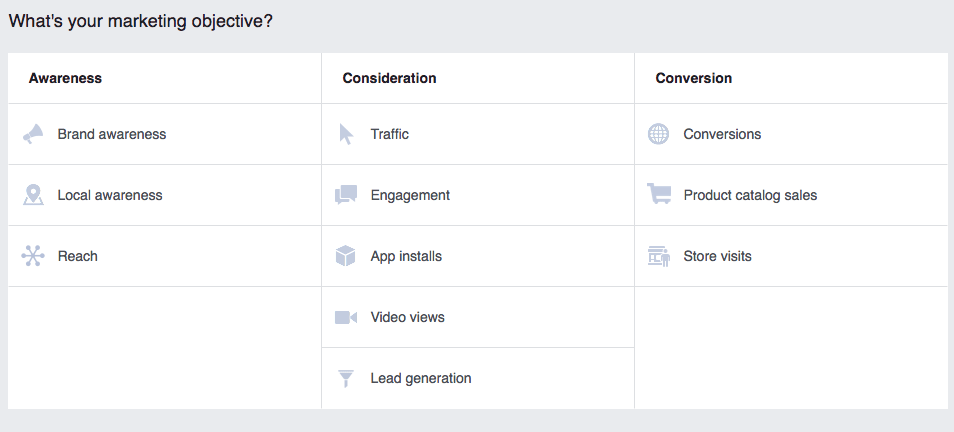
When you’re just starting out, make sure you’re not overlooking these aspects of Facebook Ads:
- Audience targeting: Take advantage of localization capabilities if applicable—the more targeted the audience, the more engagement you’ll receive for a smaller budget.
- Reach: Reach projection is important if you have conversion rates to reference. This helps match your conversion goal to your budget.
- Campaign goals: select your goal carefully—for example, marketers promoting a webinar will want to run a conversion campaign, whereas those trying to gain more followers might choose brand awareness targeting.
You’ll reach a wide audience on Facebook in a variety of countries, but if you’re trying to capitalize on trends, Twitter is your best bet.
Twitter: Capitalize on Trends
Twitter is the best place to find out what people are talking about on the web, right now. This is great news for marketers trying to capitalize on an event, holiday, season or recent news.
Twitter allows for three general types of promotions—tweets, accounts, and trends.
Promoting a tweet works very similarly to the way you sponsor a Facebook post. In this quick-promote dashboard, you can promote by location and budget parameters. For more advanced options you’ll need to open up a Twitter Ads account.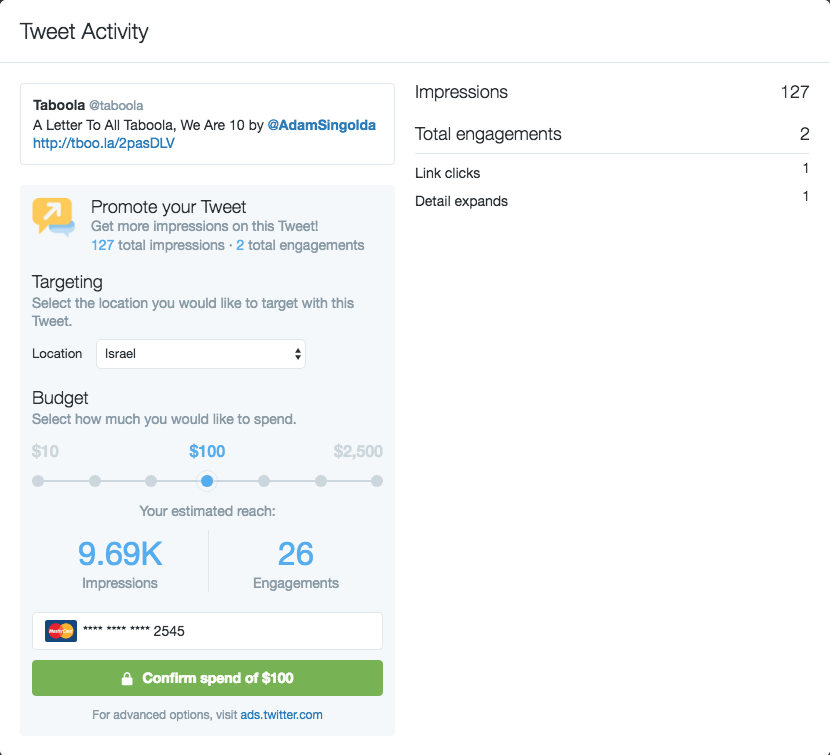
The Twitter Ads dashboard is where you can create detailed ads for all types of content—organic tweets, tweets that show in user’s feeds but not on your profile, account promotions, and campaigns that capitalize on certain trends by hashtag.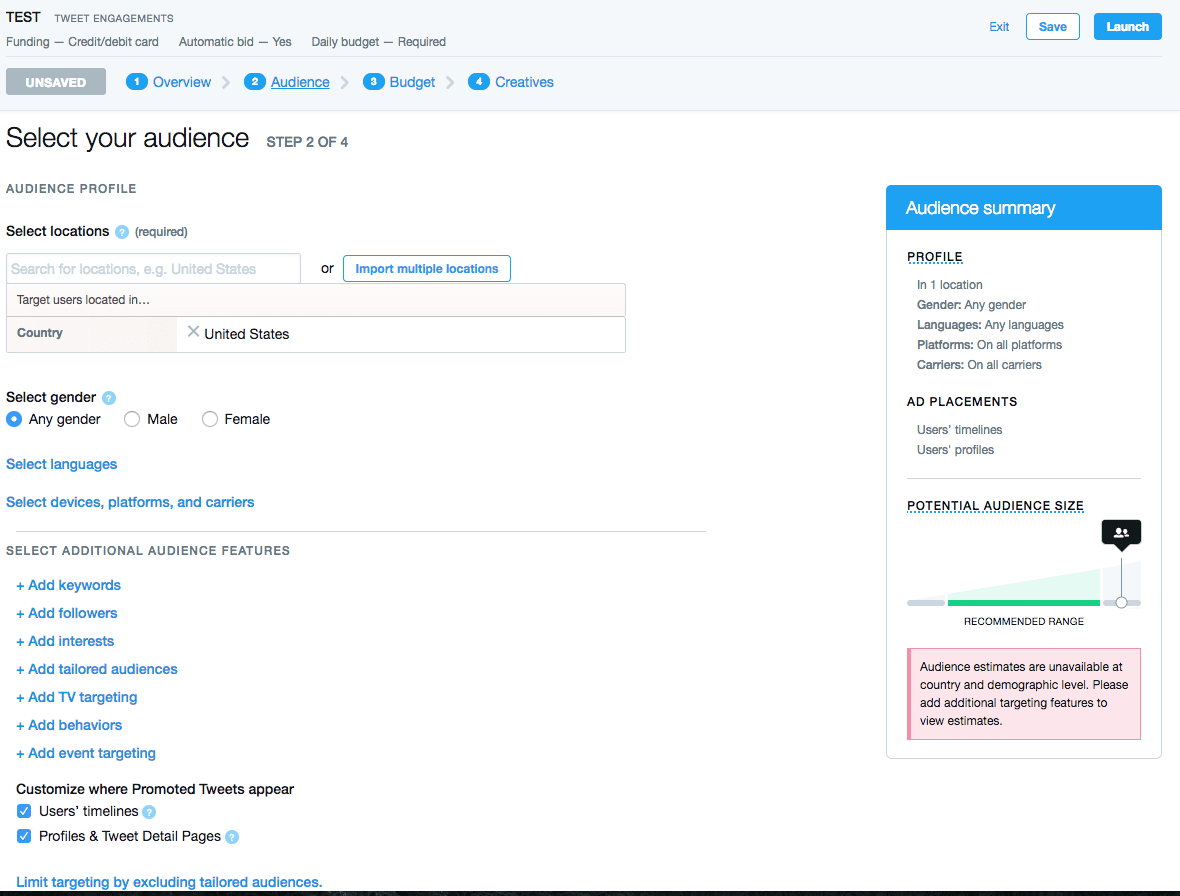
When you’re starting out with Twitter promotion, pay special attention to the following:
- Audience selection: be selective when choosing your audience parameters—get as specific as possible. The best place to do this is in keywords and interests, to start.
- Campaign creatives: it’s better to have several tweet creatives in a campaign than just one. Create several tweets to boost your chances of campaign success.
- Campaign goals: Be smart about your goals. For example, If you want web visits, consider doing a plain text tweet with a link. This optimizes your paid clicks—you’ll also pay for clicks on photos, and for the expansion of twitter cards.
For B2B marketers, or B2C companies selling business-related products, LinkedIn is your best social platform—they know your target audience by their exact title and industry.
LinkedIn: B2B Marketers can Target by Title and Industry
Just like Facebook and Twitter, LinkedIn does sponsored updates and traditional ads. It’s popular with B2B marketers because it works—HubSpot found that compared with Twitter and Facebook, it generates the highest visitor-to-lead conversion rate; nearly three times higher.
LinkedIn is a bit different—you can’t quickly sponsor an organic update from your feed. In order to run ads with LinkedIn, you must open a LinkedIn ads account.
With LinkedIn, step one is to choose your goals. You can choose between sponsored content, test advertisements and sponsored InMail.
Sponsored content is most commonly used in content marketing, but more detailed targeting is also available in text ads and sponsored inmail—here you can reach LinkedIn members directly through LinkedIn messages.
The real power of LinkedIn ads is in their audience targeting, where the professional criteria is more detailed than on any other platform.
When you’re starting out with LinkedIn ads, pay special attention to the following:
- Audience: depending on the content you’re promoting, industry, seniority and job function are a starting point when you’re trying to build an audience of the right people.
- Campaign creatives: this the platform where people are most likely to convert, so give them something to do once they click. If you’re promoting a blog post, do so with a call to subscribe.
- Budget: LinkedIn is more expensive than other social media platforms—if you’re going to invest in their ads, start with higher bids, then lower them as your audience and engagement grows.
Whether it’s through discovery, native ads, PPC or social media—the web is eager to monetize the content from brands and publishers alike. There are many options to choose from when it comes to paid promotion of your content.
When you’re just building your audience, though, you need credibility. Content marketing won’t work unless your audience can trust you.
We recommend starting with discovery, where you can promote your content on some of the best publisher sites out there, and gain the credibility needed for your audience to convert.
Taboola is the world’s leading content discovery platform, serving 360B recommendations to over 1B unique visitors each month on the web’s most innovative publisher sites. To learn more about how Taboola can help you A/B test your site content, contact us or start your campaign.

